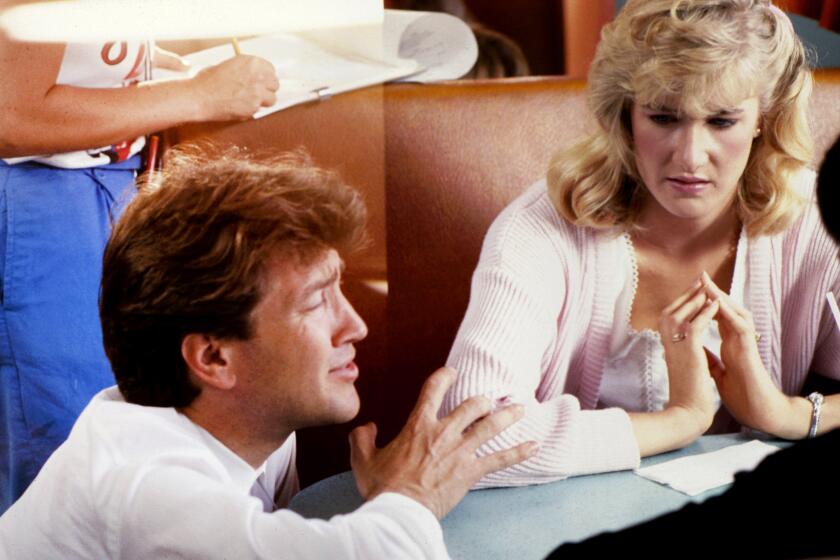From Our Blogs
- Share via
HERO COMPLEX
The fine art of scalping in film
To play up the grisly spectacle of scalping Nazi soldiers in Quentin Tarantino’s “Inglourious Basterds” required some sleight of hand as well as the makeup skill of Gregory Nicotero and the rest of the effects crew at KNB EFX.
“The way the gag works, the scalp and the actor’s head are separate,” Nicotero said. “To sell the gag, you have to pretend like you’re really putting effort into the cutting, like the knife is really slicing through skin.”
The team made a mold of make-up effects artist Jake Garber’s head and used that as the model to sculpt the scalps to be affixed to the extras’ heads.
Then they hand-painted the bloody details onto the piece and covered the whole area in a patented concoction called Ultraslime.
But to guarantee the realism of the bit, Nicotero taught the assembled “Basterds” (minus Brad Pitt) the fine art of scalping.
“It was a little overwhelming for them, because they’d all just flown into Berlin,” Nicotero said. “But they got really enthusiastic and excited. I think at one point Gedeon [actor Gedeon Burkhard] forgot there was an actor under there. He was just going to town.”
-- Patrick Kevin Day
From Hero Complex: For your inner fanboy
For more, go to latimes.com/herocomplex
BOOSTER SHOTS
It’s liver fat, not belly fat, to fear
In recent years, researchers have found evidence that fat accumulated in the abdomen appears more harmful than fat that cushions the thighs, arms or rear. This fat, called visceral fat, is thought to be active tissue that can raise the risk of insulin resistance, diabetes and heart disease.
However, new research suggests it’s not belly fat that’s bad but, rather, fat that accumulates in the liver. The study compared obese people with elevated and normal levels of liver fat and determined that excess fat inside the liver was linked to the higher risk of metabolic problems. Researchers don’t know why some fats, particularly triglycerides, accumulate inside the liver in some people but not others. But a protein that controls the transport of fatty acids from the bloodstream to various tissues is likely to be involved.
People with fatty livers should try to lose weight, the lead author of the study, Dr. Samuel Klein, said.
“Fatty liver disease is completely reversible,” said Klein, of Washington University in St. Louis. “If you lose a small amount of weight, you can markedly reduce the fat content in your liver. In fact, even two days of calorie restriction can cause a large reduction in liver fat and improvement in liver insulin sensitivity.”
The paper was published in PNAS Early Edition.
-- Shari Roan
From Booster Shots: Oddities, musings and news from the world of health
For more, go to latimes.com/boostershots
TECHNOLOGY
L.A. street traffic on Google Maps
For years, Google Maps has let the traffic-conscious peek at the congestion on freeways and highways in major cities, including Los Angeles. It’s a great service, but it has its limitations. If you’re an L.A. resident, you’re well acquainted with the sinking feeling that comes from checking your commute only to see that the Hollywood Freeway is a blood-red line all the way home. Again.
But now there’s a tail light at the end of the tunnel: Google Maps added traffic overlays to many of the Southland’s major streets -- allowing savvy, smartphone-equipped motorists to get off the freeway and find a speedier route home.
The new traffic information covers urban centers in Los Angeles, Orange and San Diego counties. To view traffic info, click the “Traffic” button on the upper right of the Google Maps window.
Google Maps imports much of its real-time traffic information from companies that monitor the nation’s roadways.
But it’s adding a high-tech twist: crowdsourcing. When mobile users call up Google Maps on their phones, the service harvests anonymous location data to enhance its picture of live road conditions.
Clearly, the next step is to develop software that lets the GPS technology in your phone process the Google Maps data and display the best route home. But in the meantime, knowing that Beverly Boulevard is green should be good enough.
-- David Sarno
From Technology: The business and culture of our digital lives
For more, go to latimes.com/technology
COMPANY TOWN
AMC moves back to Hollywood
Start popping the popcorn: AMC Entertainment, the nation’s second-largest theater operator, is moving back to Hollywood.
The Kansas City, Mo., chain, which operates 307 theaters, said Thursday it will open a new film office in Century City to strengthen its ties to the studios and develop alternative entertainment, such as live broadcasts of sporting events. The company had closed its film office in 2005 in a company-wide consolidation.
“We are pleased to reestablish a physical presence for AMC’s film team in L.A.,” said AMC Chief Executive Gerry Lopez. “The addition of new talent and the relocation of key AMC film associates will reenergize our strong industry relationships, which are integral to our programming expansion strategy.”
Robert J. Lenihan, president of programming, will oversee the new office with a staff of five in Los Angeles. The new office will be close to one of its flagship theaters, AMC Century City 15.
In February, AMC tapped Lopez, a former Starbucks Corp. executive, to become chief executive.
He replaced Peter Brown, who retired after the privately held company sustained heavy losses and dropped plans for an initial public stock offering. AMC and other theater chains have been enjoying a strong year at the box office but face long-term challenges to boost attendance and draw younger audiences.
-- Richard Verrier
From Company Town: The business behind the show
For more, go to latimes.com/companytown
More to Read
Only good movies
Get the Indie Focus newsletter, Mark Olsen's weekly guide to the world of cinema.
You may occasionally receive promotional content from the Los Angeles Times.










